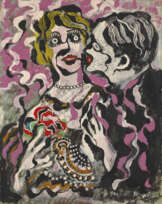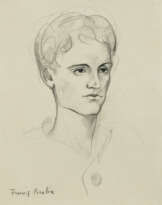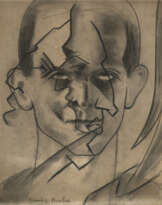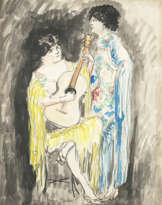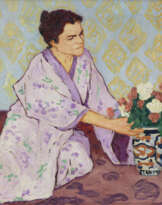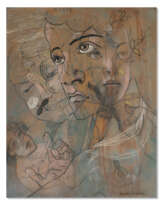ID 792300
Lot 99 | Francis Picabia (1879-1953)
Estimate value
€ 300 000 – 500 000
Maintenant et autrefois
signé et daté ‘Francis Picabia 1946’ (en bas à gauche)
huile sur toile
100.4 x 82 cm.
Peint en 1946.
signed and dated 'Francis Picabia 1946' (lower left)
oil on canvas
39 1⁄2 x 32 1⁄4 in.
Painted in 1946.
Provenance
Collection privée, Paris.
Galerie Jacques Tronche, Paris.
Puis par descendance au proprietaire actuel (vers 1993).
Literature
M. L. Borràs, Picabia, Paris, 1985, p. 533, no. 829 (illustré en couleurs, p. 471, no. 1026).
A. Pierre 'Grandeur et décadence de la peinture : Picabia dans l’après-guerre' in Francis Picabia, cat. exp., Galerie Beaubourg, Vence, 1998, p. 192.
A. Pierre 'Grandeur et décadence de la peinture : Picabia dans l’après-guerre' in A. Pierre, Francis Picabia, La peinture sans aura, Paris, 2002, p. 272.
Exhibited
Paris, Galerie René Drouin, Francis Picabia, 50 ans de plaisirs, mars 1949, no. 118.
Special Notice
On occasion, Christie's has a direct financial interest in lots consigned for sale which may include guaranteeing a minimum price or making an advance to the consignor that is secured solely by consigned property. This is such a lot. This indicates both in cases where Christie's holds the financial interest on its own, and in cases where Christie's has financed all or a part of such interest through a third party. Such third parties generally benefit financially if a guaranteed lot is sold successfully and may incur a loss if the sale is not successful.
Artist's Resale Right ("droit de Suite").
If the Artist's Resale Right Regulations 2006 apply to this lot, the buyer also agrees to pay us an amount equal to the resale royalty provided for in those Regulations, and we undertake to the buyer to pay such amount to the artist's collection agent.
Post Lot Text
"Je dois savoir ce que la peinture pense, ce que la peinture ressent, c'est-à-dire sentir les 'couleurs', aimer les 'lignes', vivre les 'formes'..."
Francis Picabia interviewé dans le Journal des Arts en 1945.
“I have to know what the painting thinks, what the painting feels, that is to say, to feel the ‘colours’, to love the ‘lines’, to experience the ‘shapes’…”
Francis Picabia interviewed in the Journal des Arts in 1945.
Selon Arnaud Pierre, la période d’après-guerre de Francis Picabia, injustement sous-estimée, est marquée « par une poussée d’irrationalisme telle qu’il n’en avait plus connue depuis les années dada, et qui le conduit à condamner tout ‘intellectualisme’, qui signe la ‘stérilité’ et ‘l’imposture’ de ‘tant de recherches artistiques’ au nom de ‘l’instinct’ omnipotent ». (A. Pierre 'Grandeur et décadence de la peinture, Picabia dans l’après-guerre' in Francis Picabia, cat. exp., Galerie Beaubourg, Vence, 1998, p. 188.) Cette iconographie ‘sur-irréaliste’ selon l’artiste, est notamment envahie de symboles de vie, comme des attributs sexuels, afin de conjurer ses angoisses morbides. En effet, affaibli par une hémorragie cérébrale en 1944, Francis Picabia lutte contre sa condition physique en s’échappant dans son art. Fentes, formes phalliques et autres allusions au corps humain abondent alors dans ses toiles, comme ici dans Maintenant et Autrefois (1946). Ici, les signes abstraits qui composent le décor du tableau rappellent l’intérêt notable du peintre pour l’automatisme, pratique surréaliste lui permettant de libérer ses pulsions artistiques inconscientes. Selon lui, « le conscient est l’évolution tardive, et par conséquent ce qu’il y a de moins fort » (F. Picabia, Écrits, Paris, 1975-78).
De ce fait, le retour aux formes primitives et au primat de l’inconscient domine la dernière période picabienne, et replace « ce vieux dadaïste impertinent » au centre de la scène artistique surréaliste d’après-guerre (M. Tapié, Un art autre, Paris, 1952). Malgré ses 75 ans, Picabia reste une figure centrale du mouvement, participant activement au Salon des Surindépendants, encourageant de nouveaux artistes tels Pierre Soulages et participant à de nombreuses expositions (comme l’exposition Francis Picabia, peintures sur-irréalistes organisée par la Galerie Denise René en 1946). Le critique Michel Tapié inclut dès lors Picabia dans les artistes « qui restent, pour les jeunes, les plus actuels, les plus disponibles » (ibid.) Ainsi, Maintenant et Autrefois rassemble tous les enjeux qui animent un Francis Picabia en quête de jeunesse, de vie et de modernité.
According to Arnaud Pierre, Francis Picabia’s unjustly underestimated postwar period was marked “by a surge of irrationalism such as he had not known since the Dada years, and which led him to condemn all ‘intellectualism’ as a sign of the ‘sterility’ and ‘imposture’ of ‘so much artistic research’ in the name of omnipotent ‘instinct’” (A. Pierre, “Grandeur et décadence de la peinture: Picabia dans l’après-guerre,” in Francis Picabia, ex. cat., Galerie Beaubourg, Vence, 1998, p. 188). This “sur-irrealistic” iconography, according to the artist, is notably pervaded by symbols of life, such as sexual attributes, in order to ward off his morbid fears. Weakened by a stroke in 1944, Francis Picabia fought against his physical condition by escaping into his art. Slits, phallic forms and other allusions to the human body abound in his paintings, as here in Maintenant et Autrefois (1946). Here, the abstract signs that make up the scene of the painting recall the painter’s marked interest in automatism, a surrealist practice that allowed him to release his unconscious artistic impulses. In his words, “the conscious is late evolution, and consequently what is least strong” (F. Picabia, Écrits, Paris, 1975-1978).
As a result, the return to primitive forms and the primacy of the unconscious dominated Picabia’s final period, and placed “this impertinent old Dadaist” at the centre of the postwar surrealist art scene (M. Tapié, Un Art Autre, Paris, 1952). Despite his 75 years, Picabia remained a central figure in the movement, actively participating in the Salon des Surindépendants, encouraging new artists such as Pierre Soulages and taking part in many exhibitions (such as the exhibit Francis Picabia: Peintures sur-irréalistes held at the Galerie Denise René in 1946). The critic Michel Tapié then included Picabia among the artists “who remain, for young people, the most up-to-date, the most accessible” (ibid.). Thus Maintenant et Autrefois encompasses all the things that drove Francis Picabia in his quest for youth, life and modernity.
| Artist: | Francis Picabia (1879 - 1953) |
|---|---|
| Applied technique: | Oil on canvas |
| Auction house category: | Paintings |
| Artist: | Francis Picabia (1879 - 1953) |
|---|---|
| Applied technique: | Oil on canvas |
| Auction house category: | Paintings |
| Address of auction |
CHRISTIE'S 9 Avenue Matignon 75008 Paris France | ||||||||||||||
|---|---|---|---|---|---|---|---|---|---|---|---|---|---|---|---|
| Preview |
| ||||||||||||||
| Phone | +33 (0)1 40 76 85 85 | ||||||||||||||
| Fax | +33 (0)1 40 76 85 86 | ||||||||||||||
| Conditions of purchase | Conditions of purchase | ||||||||||||||
| Shipping |
Postal service Courier service pickup by yourself | ||||||||||||||
| Payment methods |
Wire Transfer | ||||||||||||||
| Business hours | Business hours
|


